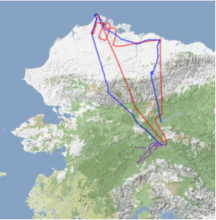- Science Team Meeting, October 23-25 in Austin, TX
You are here
News
Two engineering flights were conducted: one to check out the new Precision Platform Autopilot and the other to check out the L-band radar. We then flew our routine Sacramento Delta levee monitoring flight before heading out to the Gulf Coast on Tuesday for coastal subsidence studies and oil spill recovery monitoring. Initial assessment of engineering/calibration data showed that the radar is in good health.
The P-band radar successfully completed its Houston, TX deployment on July 23. We conducted 3 observations each over Walnut Gulch, AZ (desert shrubs) and MOISST, OK (temperate grasslands and SMAP cal/val site). Both radar and aircraft performed nominally. The JSC G-III and P-band radar are headed to Montana on Friday for the second summer campaign over Metolius Pine, Oregon and BERMS, Saskatchewan. The JPL radar team began delivery of L1 radar data from campaigns in February through June. Science team members continue to process higher level products. The PI is at IGARSS this week presenting soil moisture retrieval results from last Fall's campaigns.
The CARVE flight crew returned from Alaska and are taking well deserved vacations.
In the meantime, CARVE was recently featured on KNBC.
On July 9, the L-band radar was removed from AV-1 without accomplishing the engineering flight because HS-3 is waiting to use the aircraft. Obviously this was a very disappointing development as the radar was successfully integrated to the aircraft and ready to fly two weeks ago. The Combined Systems Test on June 25 was terminated due to an aircraft engine fault. Dryden and Northrop Grumman teams spent a week troubleshooting the fault condition and determined the probable cause to be the Vehicle Test Computer on the ground and not the aircraft engine or computer. The team was hoping to get a flight off on July 11, but the window of opportunity on the aircraft had expired, and the team was instructed to pack the radar and return home. The next window of opportunity for UAVSAR flights is in October 2013, after the HS-3 mission.
AirMOSS has completed two (2) MOISST, Oklahoma flights and two (2) Chamela, Mexico flights. Last week, ground Built-In Test revealed an issue with the P-band RF electronics which was traced to a faulty Low Power Switch Network; the box had endured water damage, was replaced with a flight spare, and flights were resumed. The team is investigating the source of the water leak. In the meantime, the flight spare unit was sealed properly to prevent any water from entering the box. When AirMOSS returns to Ontario, the team plans to install humidity sensors to monitor the humidity of the nosecone to determine when water might have entered the pod.
- What is the performance of existing NASA passive airborne remote sensing instruments HyTES, CARVE, and AVIRIS-ng, with respect to detection of ground-sourced methane?
- How well do high-resolution (≤10 m) numerical dispersion models predict methane concentration profiles as a function of meteorological conditions, surface topography/roughness, and gas flux?
- How well do small unmanned air vehicle (sUAV) in situ methane sensors map methane plumes resulting from point source releases?
CARVE flew 14 flight hours, with flights over Alaska to Minto, Innoko, Deadhorse, and Barrow. CARVE concluded the very successful June campaign on June 19.


